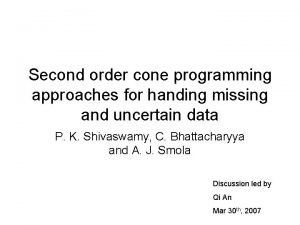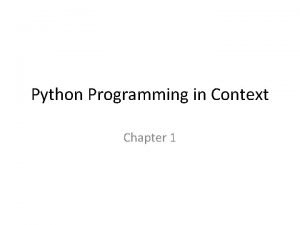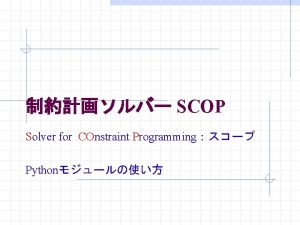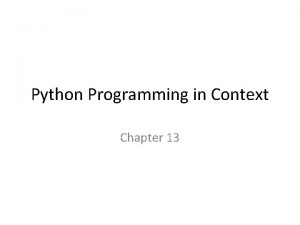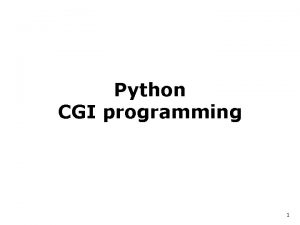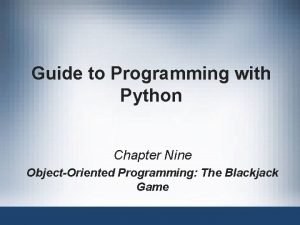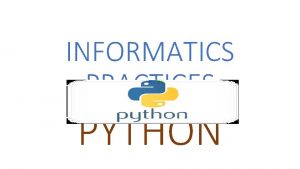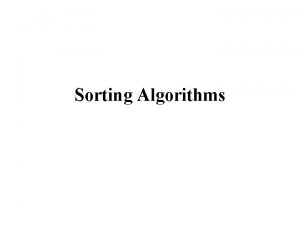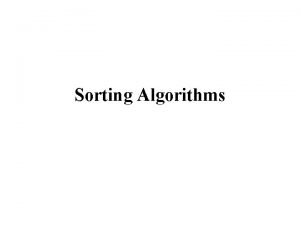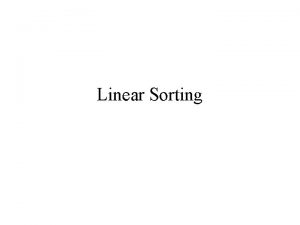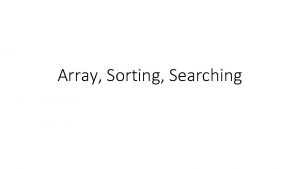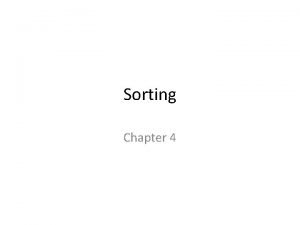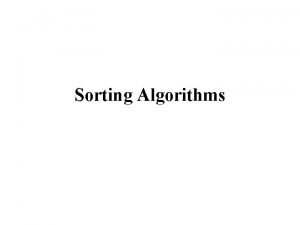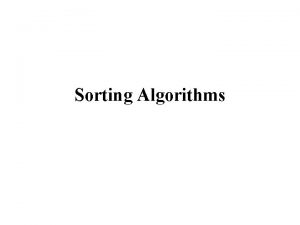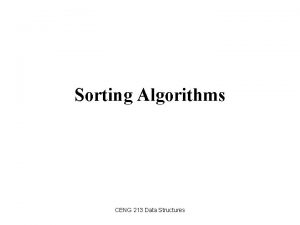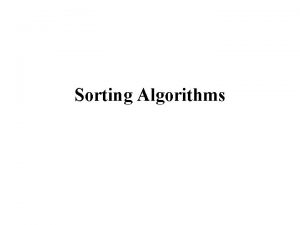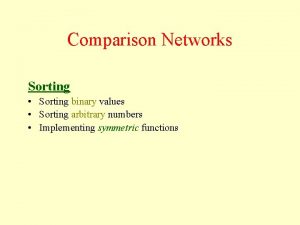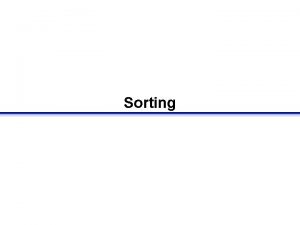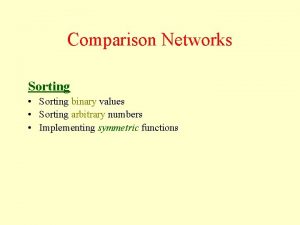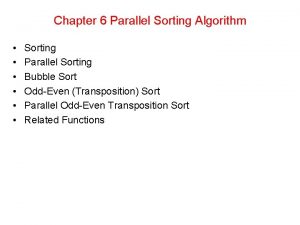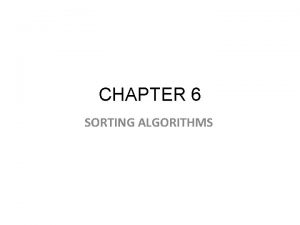Programming for Engineers in Python Lecture 9 Sorting































- Slides: 31

Programming for Engineers in Python Lecture 9: Sorting, Searching and Time Complexity Analysis Autumn 2011 -12 1

Lecture 8: Highlights Design a recursive algorithm by 1. Solving big instances using the solution to smaller instances 2. Solving directly the base cases Recursive algorithms have 1. Stopping criteria 2. Recursive case(s) 3. Construction of a solution using solution to 2 smaller instances

Today • Information • Importance of quick access to information • How can it be done? • Preprocessing the data enables fast access to what we are interested in • Example: dictionary • The most basic data structure in Python: list • Sorting preprocessing • Searching fast access • Time complexity 3

Information There about 20, 000, 000 web pages in the internet 4

Sorting • A sorted array is an array whose values are in ascending/descending order • Very useful • Sorted array example: 1 2 5 8 9 13 • Super easy in Python – the sorted function 5 67

Why is it Important to Sort Information? • To find a value, and fast! • Finding M values in a list of size N • Naive solution: given a query, traverse the list and find the value • Not efficient, average of N/2 operations per query • Better: sort the array once and than perform each query much faster 6

Why not Use Dictionaries? • Good idea! • Not appropriate for all applications: • Find the 5 most similar results to the query • Query's percentile • We will refer to array elements of the form (key, value) 7

Naïve Search in a General Array • Find location of a value in a given array 8

Binary Search (requires a sorted array) • Input: sorted array A, query k • Output: corresponding value / not found • Algorithm: • Check the middle element in A • If the corresponding key equals k return corresponding value • If k < middle find k in A[0: middle-1] • If k > middle find k in A[middle+1: end] 9

Example Searching for 56 index 0 1 2 3 4 5 6 7 8 9 value -5 -3 0 4 8 11 22 56 57 97 10

Example Searching for 4 index 0 1 2 3 4 5 6 7 8 9 value -5 -3 0 4 8 11 22 56 57 97 11

Code –Binary Search 12

Binary Search – 2 nd Try 13

Time Complexity • Worst case: • Array size decreases with every recursive call • Every step is extremely fast (constant number of operations - c) • There at most log 2(n) steps • Total of approximately c*log 2(n) • For n = 1, 000 binary search will take 20 steps - much faster than the naive search 14

Time Complexity על רגל אחת • Algorithms complexity is measured by run time and space (memory) • Ignoring quick operations that execute constant number of times (independent of input size) • Approximate time complexity in order of magnitude, denoted with O (http: //en. wikipedia. org/wiki/Big_O_notation) • Example: n = 1, 000 • O(n 2) = constant * trillion (Tera) • O(n) = constant * million (Mega) 15 • O(log 2(n)) = constant * 20

Order of Magnitude n log 2 n n 2 1 0 0 1 16 4 64 256 8 2, 048 65, 536 4, 096 12 49, 152 16, 777, 216 65, 536 16 1, 048, 565 4, 294, 967, 296 20 20, 971, 520 1, 099, 511, 627, 776 24 402, 653, 183 281, 474, 976, 710, 656 1, 048, 576 16, 777, 216 16

Graphical Comparison 17

Code – Iterative Binary Search 18

http: //www. doughellmann. com/Py. MOTW/timeit/ Testing Efficiency Preparations (Tutorial for timeit: http: //www. doughellmann. com/Py. MOTW/timeit/) 19

Testing Efficiency 20

Results 21

Until now we assumed that the array is sorted… How to sort an array efficiently? 22


Bubble Sort Example 7 2 8 5 4 2 7 5 4 8 2 5 4 7 8 2 4 5 7 8 2 7 8 5 4 2 5 7 4 8 2 4 5 7 8 2 7 5 8 4 2 5 4 7 8 (done) 2 7 5 4 8 24

Code – Bubble Sort n iterations i iterations constant (n-1 + n-2 + n-3 + …. + 1) * const ~ ½ * n 2 25


We showed that it is possible to sort in O(n 2) Can we do it faster? Yes! – Merge Sort 27

Comparing Bubble Sort with sorted 28

The Idea Behind Merge Sort • Sorting a short array is much faster than a long array • Two sorted arrays can be merged to a combined sorted array quite fast (O(n)) 29

Generic Sorting • We would like to sort all kinds of data types • Ascending / descending order • What is the difference between the different cases? • Same algorithm! • Are we required to duplicate the same algorithm for each data type? 30

The Idea Behind Generic Sorting • Write a single function that will be able to sort all types in ascending and descending order • What are the parameters? • The list • Ascending/descending order • A comparative function 31
 Difference between external and internal sorting
Difference between external and internal sorting Introduction to matlab for engineers
Introduction to matlab for engineers 01:640:244 lecture notes - lecture 15: plat, idah, farad
01:640:244 lecture notes - lecture 15: plat, idah, farad C data types with examples
C data types with examples Python procedural language
Python procedural language Python chapter 5 programming exercises
Python chapter 5 programming exercises Second order cone programming python
Second order cone programming python Python programming in context
Python programming in context Constraint programming python
Constraint programming python Rapid gui programming with python and qt
Rapid gui programming with python and qt Python programming in context
Python programming in context Python cgi form example
Python cgi form example Python audio programming
Python audio programming String python
String python Programming essentials in python
Programming essentials in python Blackjack python object oriented
Blackjack python object oriented Python programming an introduction to computer science
Python programming an introduction to computer science Perbedaan linear programming dan integer programming
Perbedaan linear programming dan integer programming Greedy vs dynamic programming
Greedy vs dynamic programming What is in system programming
What is in system programming Integer programming vs linear programming
Integer programming vs linear programming Definisi linear
Definisi linear Fspos
Fspos Novell typiska drag
Novell typiska drag Nationell inriktning för artificiell intelligens
Nationell inriktning för artificiell intelligens Vad står k.r.å.k.a.n för
Vad står k.r.å.k.a.n för Varför kallas perioden 1918-1939 för mellankrigstiden?
Varför kallas perioden 1918-1939 för mellankrigstiden? En lathund för arbete med kontinuitetshantering
En lathund för arbete med kontinuitetshantering Personalliggare bygg undantag
Personalliggare bygg undantag Personlig tidbok för yrkesförare
Personlig tidbok för yrkesförare A gastrica
A gastrica Vad är densitet
Vad är densitet






